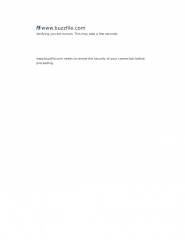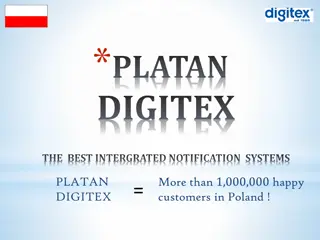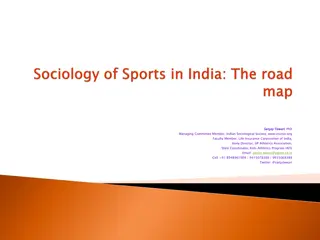STRATEGIC MANAGEMENT IN POLISH SPORT FEDERATIONS
This article by Michael Troilo explores the strategic management practices in Polish sport federations through a comprehensive SWOT analysis, providing valuable insights and recommendations for improvement.
Download Presentation

Please find below an Image/Link to download the presentation.
The content on the website is provided AS IS for your information and personal use only. It may not be sold, licensed, or shared on other websites without obtaining consent from the author.If you encounter any issues during the download, it is possible that the publisher has removed the file from their server.
You are allowed to download the files provided on this website for personal or commercial use, subject to the condition that they are used lawfully. All files are the property of their respective owners.
The content on the website is provided AS IS for your information and personal use only. It may not be sold, licensed, or shared on other websites without obtaining consent from the author.
E N D
Presentation Transcript
STRATEGIC MANAGEMENT IN POLISH SPORT FEDERATIONS - SWOT ANALYSIS Michael Troilo, PhD Wellspring Associate Professor of Finance and International Business Warsaw - 29/05/2018
Agenda 1. Introduction: What is SWOT? 2. Looking internally at strengths and weaknesses. - Identifying core competencies - Assessing financial capacity for new strategies - Evaluating management culture for readiness to change. 3. Looking externally at threats and opportunities. - Detecting and categorizing threats and opportunities - Analyzing customers - Changes in the competitive environment 2
SWOT Strengths: Capabilities that enable your organization to perform well. They are a source of leverage Weaknesses: Characteristics that prohibit your organization from performing well. They need to be addressed. Opportunities: organization can exploit. Trends, forces, events, and ideas that your Threats: Possible events or forces beyond your organization s control that you need to mitigate. 3 (From Strategy: Create and Implement the Best Strategy for Your Business HBS, 2005)
Core Competencies - Core competencies are an organization s expertise or skills in key areas that directly produce superior performance, e.g. technical abilities, managerial know-how, customer service. - For a skill to be a core competency, it must confer a sustainable competitive advantage. What does your organization do uniquely well that others value? - Benchmarking is a means to discover core competencies. The benchmark may be in another industry, e.g. airlines and ticket pricing. 4 (From Strategy: Create and Implement the Best Strategy for Your Business HBS, 2005)
Elements of a solid core competency Inimitability: Hard to copy. Durability: Continuing value over a long period of time, e.g. brand names like Coca-Cola, Disney. Appropriability: Can others take the value you ve created? In some industries, retailers have the power to take value. Sustainability: Are there available substitutes for your competency? Competitive superiority: Is your competency truly superior to your rivals, or is it merely good? 5 (From Strategy: Create and Implement the Best Strategy for Your Business HBS, 2005)
Example of benchmarking COMPANY 1 COMPANY 2 COMPANY 3 Time to market 5 2 3 Quality 4 4 5 Service 4 2 5 Customer satisfaction 5 2 4 Human resources 4 2 4 (5-Very Strong, 1-Very Weak) 6 (From Strategy: Create and Implement the Best Strategy for Your Business HBS, 2005)
Financial condition: Can you afford your strategy? - Cash flows: Are operating cash flows sufficient for your plans? - Access to outside capital. - Cost of borrowing/debt - Capacity for additional debt - Cost of equity, if applicable - Other scheduled spending, e.g. purchase of land. - Hurdle rate of new projects: The hurdle rate is the minimum rate of return. 7 (From Strategy: Create and Implement the Best Strategy for Your Business HBS, 2005)
Management and Culture: How does your organization handle change?? - Are your managers respected and effective? - Do people feel personally motivated to change? - Is your organizational structure flat, i.e. there are few layers between the workers and the CEO - Is teamwork and collaboration normal? - Are people accountable for their results? - Is good performance rewarded? 8 (From Strategy: Create and Implement the Best Strategy for Your Business HBS, 2005)
Group exercise - Divide into six teams of six to seven people - Each team should consider strengths and weaknesses of their respective sport organizations. What are some in common? - Spend 15 minutes with your team in discussions - Each team will have one speaker report their findings to the entire group. Each speaker should only speak 2-3 minutes. 10
SWOT Strengths: Capabilities that enable your organization to perform well. They are a source of leverage Weaknesses: Characteristics that prohibit your organization from performing well. They need to be addressed. Opportunities: organization can exploit. Trends, forces, events, and ideas that your Threats: Possible events or forces beyond your organization s control that you need to mitigate. 11 (From Strategy: Create and Implement the Best Strategy for Your Business HBS, 2005)
External Analysis Porter, The essence of strategy is relating an organization to its environment . The environment: - Customers - Competitors - Suppliers - Regulators - Technology -Substitutes An example from the US: Concussions in American football. 12 (From Strategy: Create and Implement the Best Strategy for Your Business HBS, 2005)
Customers - Who are your customers? This may seem like a simple question, but many companies forget to ask it. - What is the best way to reach my customers? - How price-sensitive are my customers? Sports and leisure are usually luxury goods. - What customer needs are not being met? - How loyal are my customers? - Market segmentation: Age, behavior, etc. gender, location, income, 13 (From Strategy: Create and Implement the Best Strategy for Your Business HBS, 2005)
PORTERS FIVE FORCES - Competitive rivalry - Threat of new entry - Threat of substitution - Supplier power - Buyer power The above are the original, but sometimes Regulators are added as a sixth force. (From Strategy: Create and Implement the Best Strategy for Your Business HBS, 2005)
Competitive Rivalry - Number of competitors - Quality differences - Other differences - Switching costs, e.g. cell phones and providers - Customer loyalty 15 (From Strategy: Create and Implement the Best Strategy for Your Business HBS, 2005)
Threat of new entry - Time and cost of entry - Specialized knowledge - Economies of scale - Cost advantages - Technology protection - Barriers to entry 16 (From Strategy: Create and Implement the Best Strategy for Your Business HBS, 2005)
Threat of substitution - Availability of substitutes - Performance of substitutes - Cost of substitutes 17 (From Strategy: Create and Implement the Best Strategy for Your Business HBS, 2005)
Supplier power - Number of suppliers - Size of suppliers - Uniqueness of service - Switching costs - Substitutes 18 (From Strategy: Create and Implement the Best Strategy for Your Business HBS, 2005)
Buyer power - Number of customers - Size of each order - Differences between competitors - Price sensitivity - Substitutes 19 (From Strategy: Create and Implement the Best Strategy for Your Business HBS, 2005)
Group exercise - Divide into six teams of six to seven people - Each team should consider threats and opportunities of their - respective sport organizations. What are some in common? - Spend 15 minutes with your team in discussions - Each team will have one speaker report their findings to the entire group. Each speaker should only speak 2-3 minutes 21
Thank you Michael Troilo, PhD Wellspring Associate Professor of Finance and International Business 22























